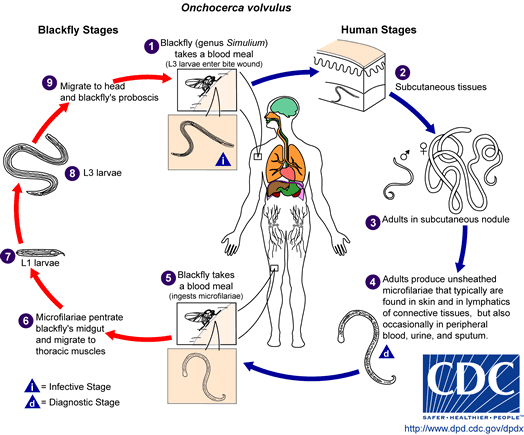Introduction to Diagnostic Medical Parasitology
Essentials
The infectious agent is Onchocerca volvulus, a filarial tissue-dwelling nematode worm, found predominantly in the skin and the eye. Onchocerciasis is endemic in tropical Africa and parts of southern America.

Following the bite of an infected female black fly (Simulium spp.), a non-fatal filarial disease develops. Fibrous nodules are formed around developing adult worms (female worms reach a length of up to 50 cm) in the subcutaneous tissues, especially of the head and shoulders (America) or the pelvic girdle and lower limbs (Africa). Female worms are viviparous: microfilariae (300 µm long) are mainly found in intercellular spaces in the dermis and in the eye chambers. When black flies feed on an infected patient, microfilariae are taken up with the blood meal (pool feeders). They have to escape blood digestion in the vector by invading the body cavity of the insect. Within flight muscle fibres, they develop to third-stage (infectious) larvae which leave the insect actively during the next blood meal.



Epidemiology
- Onchocerciasis is endemic in tropical Africa (in sub-Saharan Africa from Senegal to Ethiopia)
- Latin America (Guatemala, southern Mexico, Venezuela, Colombia, Ecuador, Brazil)
- Transmission of the disease occurs by bites of black flies

Pathology
- Skin and eye lesions are due to dying microfilariae
- A variety of skin manifestations can be observed
- Skin nodules of various sizes in the dermis or subcutaneous tissues contain adult worms
- Severe ocular pathology involves different tissues, is progressive and may end in blindness
Clinical Findings
- Skin manifestations include:
- Pruritus, rash (when microfilariae die)
- Chronic dermatitis and altered pigmentation
- Oedema and atrophy of the skin
- Loss of skin elasticity
- Lymphadenitis
- Pigment changes known as “leopard skin”
- Nodules (onchocercomas) contain live or calcified adult worms
- Eye manifestations are due to dying microfilariae and include:
- Punctate keratitis
- Sclerosing keratitis
- Anterior uveitis
- Chorioretinal lesions
- Inflammation and atrophy of the optic nerve
- Blindness
Diagnosis
Diagnostic methods
Parasitological diagnosis
The classical way to diagnose onchocerciasis is by taking skin snips (six or more) and detecting microfilariae. However, the sensitivity is restricted in light infections (e.g. in drug- or vector-controlled areas).
Molecular diagnosis
Molecular methods have been described to demonstrate strain differences (e.g. between forest and savannah). In addition, infective larvae from related species can be differentiated from O. volvulus.
Detecting DNA in skin snips may improve sensitivity but needs biopsies.
Antigen detection
A new antigen detection dipstick method has been described which showed high sensitivity when urine samples were tested. Specificity also seems to be excellent.
Antibody detection
Many attempts have been undertaken to improve specificity of serological methods by using recombinant antigens. However, a decrease in sensitivity has often been observed. In a rapid format card test, IgG4 antibodies have been detected using the Ov16 recombinant antigen.
Diagnostic strategies
- To diagnose an individual case
In returning travellers with limited exposure, definite diagnosis is difficult to achieve. One might combine clinical findings, skin snips and the demonstration of specific serum antibodies.
- To assess a control programme
Detecting microfilariae in skin snips is not adequate for the assessment of a control programme due to the low sensitivity of this method and the length of the pre-patent period. There have been many attempts to develop immunological methods for early diagnosis. However, they were either unsuccessful or have not been fully validated so far.

Prevention and control
- Vector control programmes
The incidence of new infection in West Africa has been reduced thanks to a large-scale campaign, the Onchocerciasis Control Program (OCP) - Annual mass chemotherapy
- Personal protection: avoid bites of black flies (Simulium spp.) by wearing protective clothing and using repellents